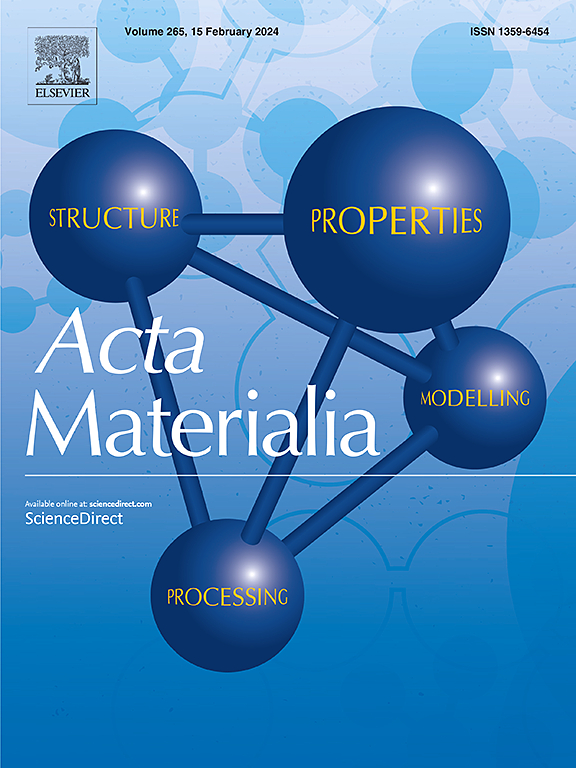Heterogeneous fatigue damage in a nickel-based single-crystal superalloy unraveled using correlative 3D X-ray technology
IF 9.3
1区 材料科学
Q1 MATERIALS SCIENCE, MULTIDISCIPLINARY
引用次数: 0
Abstract
Nickel-based single-crystal (Ni-SX) superalloys under cyclic stress are susceptible to cracking at stress-concentration sites, eventually leading to low-cycle fatigue (LCF) failure. LCF cracks typically originate from intrinsic defects (e.g., voids and carbides) within solidified dendrites. However, systematic quantitative experimental analyses of defect-mediated local damage remain limited. To thoroughly understand the microscopic origins and evolution of LCF damage, correlated 3D mapping of dendrites across various regions is essential. Here, macroscale micro-computed tomography (μ-CT) was initially used to capture internal interdendritic secondary cracks within bulk DD413 superalloy after LCF testing at 760 °C. Subsequently, a multimodal methodology combining synchrotron 3D microdiffraction (3D-μXRD), high-resolution μ-CT, and electron microscopy was established. This approach allowed precise localization of internal damage zones near interdendritic secondary cracks and detailed mapping of the 3D correlated distributions of dendrites, defects, and residual stress/strain fields within these zones at submicron spatial resolution. Finally, the same approach was applied to specimens subjected to interrupted loading at approximately 40 % of the fatigue life to uncover the early damage states of dendrites. The dendrite cores (DCs) and interdendritic regions (IDs) exhibit microscale heterogeneous mechanical responses: nearly defect-free DCs accumulate local irreversible slip along specific slip systems to generate slip bands, while the IDs containing various defects accommodate local microplasticity through the activation of multiple slip systems around these defects. The local tensile stress near defects in the IDs exceeds that in the DC slip band regions by more than threefold, leading to the generation of local damage zones within the IDs. Chain-like defect distributions facilitate the interconnection of these local zones into a continuous damage region, further elevating the overall tensile stress in the IDs. Additionally, geometrically necessary dislocations alone are insufficient as indicators of LCF damage; both the internal stress state and its magnitude must be considered. These experimental results provide critical data and insights for the development of multi-physics fatigue models.


利用相关三维x射线技术展开镍基单晶高温合金的非均质疲劳损伤
在循环应力作用下,镍基单晶高温合金在应力集中部位容易发生开裂,最终导致低周疲劳失效。LCF裂纹通常源于固化枝晶内部的固有缺陷(如空洞和碳化物)。然而,系统的定量实验分析缺陷介导的局部损伤仍然有限。为了彻底了解LCF损伤的微观起源和演化,必须对不同区域的树突进行相关的三维绘图。本文采用宏观微计算机断层扫描(μ-CT)技术,对760℃LCF测试后的大块DD413高温合金枝晶间次生裂纹进行了初步捕获。随后,建立了一种结合同步加速器三维微衍射(3D- xrd)、高分辨率μ ct和电子显微镜的多模态方法。这种方法可以精确定位树枝晶间次生裂纹附近的内部损伤区域,并以亚微米空间分辨率详细绘制这些区域内枝晶、缺陷和残余应力/应变场的3D相关分布。最后,将相同的方法应用于在大约40%疲劳寿命时遭受中断加载的试样,以揭示枝晶的早期损伤状态。枝晶核(dc)和枝晶间区(id)表现出微观尺度的非均匀力学响应:几乎没有缺陷的dc沿着特定的滑移系统积累局部不可逆滑移以产生滑移带,而含有各种缺陷的id通过激活这些缺陷周围的多个滑移系统来适应局部微塑性。内径缺陷附近的局部拉伸应力超过直流滑移带区域的3倍以上,导致内径内部产生局部损伤区。链状缺陷的分布促进了这些局部区域的互连,形成一个连续的损伤区域,进一步提高了IDs中的整体拉伸应力。此外,几何上必要的位错不足以作为LCF损伤的指标;内应力状态和大小都必须考虑。这些实验结果为多物理场疲劳模型的发展提供了重要的数据和见解。
本文章由计算机程序翻译,如有差异,请以英文原文为准。
求助全文
约1分钟内获得全文
求助全文
来源期刊

Acta Materialia
工程技术-材料科学:综合
CiteScore
16.10
自引率
8.50%
发文量
801
审稿时长
53 days
期刊介绍:
Acta Materialia serves as a platform for publishing full-length, original papers and commissioned overviews that contribute to a profound understanding of the correlation between the processing, structure, and properties of inorganic materials. The journal seeks papers with high impact potential or those that significantly propel the field forward. The scope includes the atomic and molecular arrangements, chemical and electronic structures, and microstructure of materials, focusing on their mechanical or functional behavior across all length scales, including nanostructures.
 求助内容:
求助内容: 应助结果提醒方式:
应助结果提醒方式:


